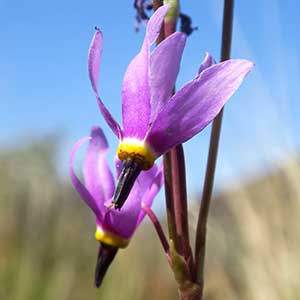Dodecatheon conjugens
Dodecatheon utahense
Bonneville shooting star, desert shootingstar, slim-pod shooting star
Wasatch shootingstar
not obvious at anthesis;
roots whitish;
bulblets absent.
not obvious at anthesis;
roots whitish;
bulblets absent.
3–13(–18) × 0.7–2.5(–4) cm;
petiole slender (at least proximally);
blade narrowly oblanceolate to spatulate or obovate, base usually not decurrent onto stem, usually abruptly tapering to petiole, margins entire, surfaces glabrous or glandular-puberulent.
4–12(–20) × (1–)1.5–4(–4.5) cm;
petiole slender (at least basally);
blade oblanceolate to broadly elliptic, base slightly decurrent onto stem in some, abruptly tapering to petiole, margins slightly sinuate to subentire, surfaces glabrous.
1–7(–10)-flowered;
bracts lanceolate to broadly lanceolate, 3–10 mm, glandular-puberulent.
2–6(–9)-flowered;
bracts linear to narrowly lanceolate, 4–8(–10) mm, glabrous.
1–5 cm, glabrous or glandular-puberulent.
(0.5–)0.8–3.5(–4.5) cm, glabrous.
calyx light green to yellowish, sometimes finely purple-speckled or -dotted, 5–12 mm, glabrous or glandular-puberulent, tube 2–6 mm, lobes 5, 3–7 mm;
corolla tube yellowish with purplish red, thin, wavy ring, lobes 5, usually magenta, sometimes white, 7–25(–35) mm;
filaments usually distinct, yellowish or dark maroon, 0.5–1.5 mm, rarely partially connate and tube 0.5–1.5 × 1.5–5 mm;
anthers 5–9 mm;
pollen sacs usually maroon or yellow, sometimes yellowish and speckled maroon, rarely with reddish purple to purple speckles, connective usually maroon, sometimes yellowish or light blue to whitish, transversely rugose;
stigma not enlarged compared to style.
calyx green, speckled with maroon, 3–6 mm, glabrous, tube 1–3 mm, lobes 5, 2–3 mm;
corolla tube white or yellowish with reddish to maroon, thin, wavy ring, lobes 5, pale lavender to pink, (7–)10–16 mm;
filaments slightly connate, tube yellow with maroon speckles or stripes to purplish maroon, 0.5–1.8 × 0.5–1 mm;
anthers (5–)6–7.5 mm;
pollen sacs maroon, connective dark purple to maroon, smooth;
stigma not enlarged compared to style.
tan, often striped with purple, usually operculate, rarely valvate, cylindric-ovoid, 8–17(–22) × 4–6(–8) mm, glabrous;
walls thin, pliable.
light green to tan, often speckled with maroon, reddish brown apically, valvate, narrowly ovoid, 8–10 × 3–4 mm, glabrous;
walls thin, pliable.
without membrane along edges.
without membrane along edges.
= 44.
Dodecatheon conjugens
Dodecatheon utahense
Varieties 2 (2 in the flora).
Both Dodecatheon conjugens and D. poeticum occur in proximity in the Columbia River gorge. Some specimens here assigned to var. conjugens may have scattered, minute glands on the pedicels that might indicate past hybridization with D. poeticum (e.g., G. N. Jones 6286, ORE; R. R. Halse 3790, OSC, WTU). Dodecatheon poeticum is densely glandular not only on the pedicels, but also on the calyx and scape. The type of minute glandular puberulence seen on var. conjugens found along the Columbia River west of The Dalles is somewhat similar to that seen on var. viscidum in western Montana and Canada. Some plants referred here to D. conjugens have slightly connate filaments that may indicate some intergradation with D. pulchellum var. pulchellum. This suggestion is supported by the tendency in the same plants to have narrower leaves.
Some newly emerged flowers tend to have connectives that are less rugose than normal. This is particularly true of some populations in southern Alberta and, to a lesser degree, in Saskatchewan.
(Discussion copyrighted by Flora of North America; reprinted with permission.)
Of conservation concern.
Dodecatheon utahense is known only from from both sides of the road at Moss Ledge in Big Cottonwood Canyon and from the Lake Blance area, Salt Lake County. The plants can have a narrow caudex to which long trailing leaves and roots are attached, the plants often hanging from steep canyon walls. Other plants tend to occur in the cracks of the rocks on a compact caudex; these plants usually are upright and tend to be much shorter (to 20 cm) compared to the hanging plants.
(Discussion copyrighted by Flora of North America; reprinted with permission.)
1. Leaf blades, scapes, and pedicels glabrous. | var. conjugens |
1. Leaf blades, scapes proximally, and pedicels usually glandular-puberulent. | var. viscidum |
- Local floras:
BC,
CA,
OR,
WA
- Local Web sites:
CalFlora,
CalPhotos,
Flora NW,
PNW Herbaria,
Turner Photog.
WildflowerSearch
iNaturalist (observations)
USDA Plants Database
- LBJ Wildflower Center
- SEINet
- Plants of the World Online
- Encyclopedia of Life
- Wikipedia
- Google Image Search


